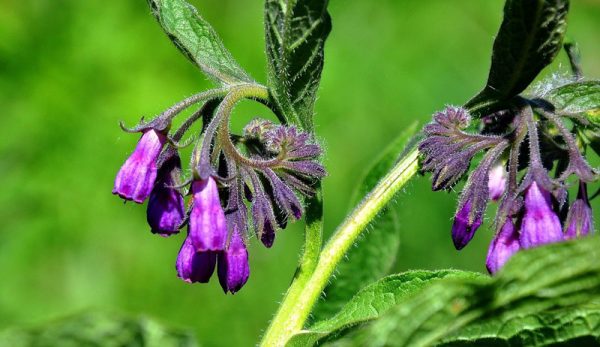
Comfrey is an herb worthy of consideration in gardens of all sizes. Its usefulness in the apothecary, in the compost or as a fertilizer makes this herb one of the most valuable plants that any gardener could grow.
The common comfrey, Symphytum officinale, is a perennial plant in the borage family, native to Europe but now widely naturalized throughout western Asia as well as most of North America. Spread by seed, it can quickly overtake an area, especially if not harvested or properly managed.
A hybrid, Sympytum x uplandicum, or Russian comfrey, has gained in popularity amongst gardeners and permaculturists alike. It’s a sterile plant that does not produce seeds, so you propagate this Russian variety through root division or by stem cuttings.
Using Comfrey in the Garden
Even just a handful of plants will provide the gardener with endless value. Rich in silica, nitrogen, magnesium, calcium, potassium and iron, add comfrey leaves to compost bins as a natural activator. Or you can shred them and utilize as a nutrient-dense mulch around fruit trees, tomatoes and other garden crops.
The long, dark taproots dig deep into the soil. They extract nutrients inaccessible to many other garden crops.
You can also brew the leaves into a potent liquid fertilizer often referred to by gardeners as simply “comfrey tea,” which is easy to make!
- Harvest comfrey leaves until you have enough to fill a 5-gallon bucket.
- Allow the leaves to wilt in the sun for one or two hours, then pack them into the bucket.
- Fill the bucket with water and loosely cover.
- Allow to ferment for several weeks, stirring every few days.
- Strain out the plant material and dilute the ‘tea’ with water at a 10:1 ratio.
- Use as a foliar spray on your garden plants.
Read more: Improve your soil with these homemade fertilizers!
Comfrey in the Apothecary
Herbalists have made use of comfrey for centuries, prescribing the herb for a wide range of ailments.
Modern practitioners avoid internal use due to the herb’s high pyrrolizidine alkaloid content. (The compound which is considered toxic and potentially damaging to the liver.) But topical applications are still commonly used.
You can craft a simple herbal salve from comfrey leaves to treat all manner of external ailments, including:
- cuts
- scrapes
- insect bites
- bruises
- sore joints
You can easily make this product by infusing dried comfrey leaves in olive or sunflower oil. Then just blend the herbal oil with melted beeswax. (If you’d like to go deeper into herbal salves, I provide more detailed information in my book The Artisan Herbalist.)
Read more: These 7 healing herbs can aid you with pain relief.
Growing Comfrey
Comfrey is easy to grow and very vigorous. It does well in full sun or partial shade. Once established, in fact, you might struggle to fully remove it!
Even the smallest piece of root left behind will quickly become an established plant.
Growing comfrey from seed can take some time. The seeds first need to be stratified, or exposed to a period of cold temperatures, and then planted in warm soil. This process could take up to two months or longer. For this reason, comfrey is most commonly propagated by root division.
As long as the plants will have time to get established before frost sets in, you can plant your comfrey roots any time of year, although spring and fall plantings are recommended. Plants will reach anywhere from 2 to 5 feet in height, and healthy plants can be lightly harvested from as early as their first year.
The blue-purple, bell-shaped flowers attract a variety of pollinators and predatory insects as well, which just another great reason to grow comfrey, the all-purpose powerhouse herb of the garden!




